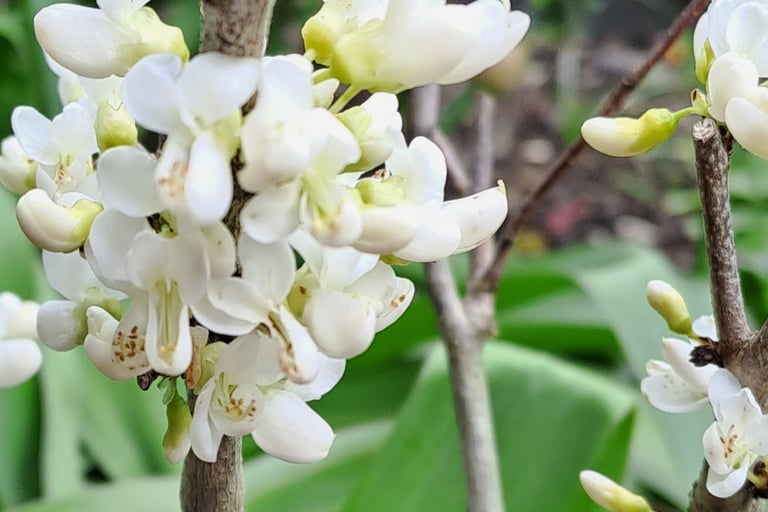Cercis
Botanical name: Cercis spp.
Common name: Redbud, Judas tree, Eastern redbud
Family: Fabaceae (pea/legume family)
Type: Deciduous broadleaf tree / small tree
Origin: Temperate regions of Europe, western Asia and North America
Characteristics
Habit: Rounded, multi-branched small tree with a short trunk; naturally becoming a small, spreading tree 4–10 m in landscape form (much smaller as bonsai).
Leaves: Heart-shaped (cordate), simple, alternate; relatively large for a bonsai (leaf reduction and regular defoliation often used).
Flowers: Small pea-like blossoms borne directly on bare wood and branches (cauliflorous) in early spring, usually pink to magenta (some varieties pale pink or white). Flowers often appear before the leaves.
Bark & trunk: Smooth, grey to brown when young; gains some texture with age—good potential for interesting movement and flower display on older trunks.
Fruit: Flat legume pods appear after flowering; can be left or removed depending on aesthetic preference.
Growth rate: Moderate; responds well to pruning but may need encouragement to ramify.
Cultivation
Light: Full sun to light afternoon shade. Full sun promotes best flowering; in very hot climates some afternoon shade reduces leaf scorch.
Temperature: Hardy in many temperate zones (species dependent). Protect from extreme late-spring frosts which can damage early flowers.
Soil: A free-draining, slightly acidic to neutral bonsai mix (e.g., akadama/kanuma/perlite). Avoid waterlogged mixes, roots dislike continuous saturation.
Watering: Keep evenly moist during active growth; avoid letting the soil dry out completely. Slightly drier in late autumn before dormancy.
Fertilizer: Regular feeding in spring and summer (balanced N-P-K). Reduce nitrogen in late summer/early autumn to encourage hardening off and flowering next spring.
Pruning: Light structural pruning in late winter/early spring (while dormant) and maintenance pruning in the growing season. Pinch new shoots to encourage ramification.
Repotting: Young trees every 1–3 years depending on vigor; more mature bonsai every 3–5 years. Best done in spring just before bud burst.
Pests & diseases: Watch for scale, aphids, leaf spots and root issues if overwatered. Good hygiene and adequate airflow help prevent fungal disease.
Propagation
Seed: Reliable for species propagation; seeds often require scarification or cold stratification to break dormancy. Seed-grown trees may take longer to flower but develop strong trunks.
Cuttings: Semi-ripe cuttings in summer can succeed (use rooting hormone, a humid environment and bottom heat).
Layering: Air-layering works well to produce a new trunk with established roots.
Grafting: Sometimes used to combine desirable scions (flower color, form) onto vigorous rootstocks, or to graft onto a different Cercis species for vigour.
Bonsai notes
Cercis is prized for its pea-like spring flowers which appear directly on the branches and even trunk
Leaves are relatively large although defoliation (full or partial) on healthy trees can help. Also, encourage finer branching by regular pinching of shoots to build up denser ramification which will help reduce leaf size.
Branches are moderately flexible in spring and summer, however, wire carefully and avoid damaging bark. Remove wiring before it starts to bite in; younger wood heals fast but is still susceptible to scarring.
Many Cercis are hardy but benefit from sheltered winter placement in cold climates. Protect from prolonged waterlogged soil in winter.
Cercis Species
Cercis siliquastrum (Judas Tree / Mediterranean Redbud)
Southern Europe & Western Asia. Heart-shaped leaves, pink-purple flowers directly on old wood. Strong trunk character, attractive bark, and profuse spring flowering. Best for medium to large bonsai; tolerates pruning well once established.
Cercis canadensis (Eastern Redbud)
Eastern North America. Compact growth, early pink blossoms, and good cold tolerance.
Varieties for bonsai:
Forest Pansy – purple leaves, beautiful contrast.
Ruby Falls – dwarf, weeping habit, ideal for cascade or shohin.
Little Woody – compact dwarf form with small leaves.
Cercis chinensis (Chinese Redbud)
China. Smaller leaves and flowers than C. canadensis; naturally shrubby. Excellent leaf-to-flower ratio and small internodes; ideal for shohin or medium bonsai. Thrives in warm temperate climates, but also hardy to -15c providing wood has ripened. Shirobana is a beautiful white-flowered cultivar.
Cercis occidentalis (Western Redbud)
Western North America. Smaller, rounded leaves and vivid magenta flowers. Naturally compact and drought-tolerant; good for small bonsai. Leaf reduction is easier compared to C. canadensis.
Cercis reniformis (Oklahoma Redbud)
South-central USA. Glossy, rounded leaves; dense branching; rich purple-pink flowers. Stronger branch structure and smaller leaves than C. canadensis.
Cercis chinensis var. avium / var. pubescens (Chinese / Hairy Redbud forms)
Dwarf, fine-leaved subspecies of Chinese redbud. Smaller foliage and fine twigs make them particularly good for detailed bonsai.
Cercis glabra (Smooth Redbud)
Central China. Smooth bark, slender growth, and pink-purple flowers.
Cercis griffithii (Afghan Redbud)
Central Asia. Smaller leaves, good drought tolerance, and fine branching. Rare species but promising for smaller bonsai in warm, dry climates. Also hardy to -10.




Get in touch for collaborations and inquiries
© 2025. All rights reserved.